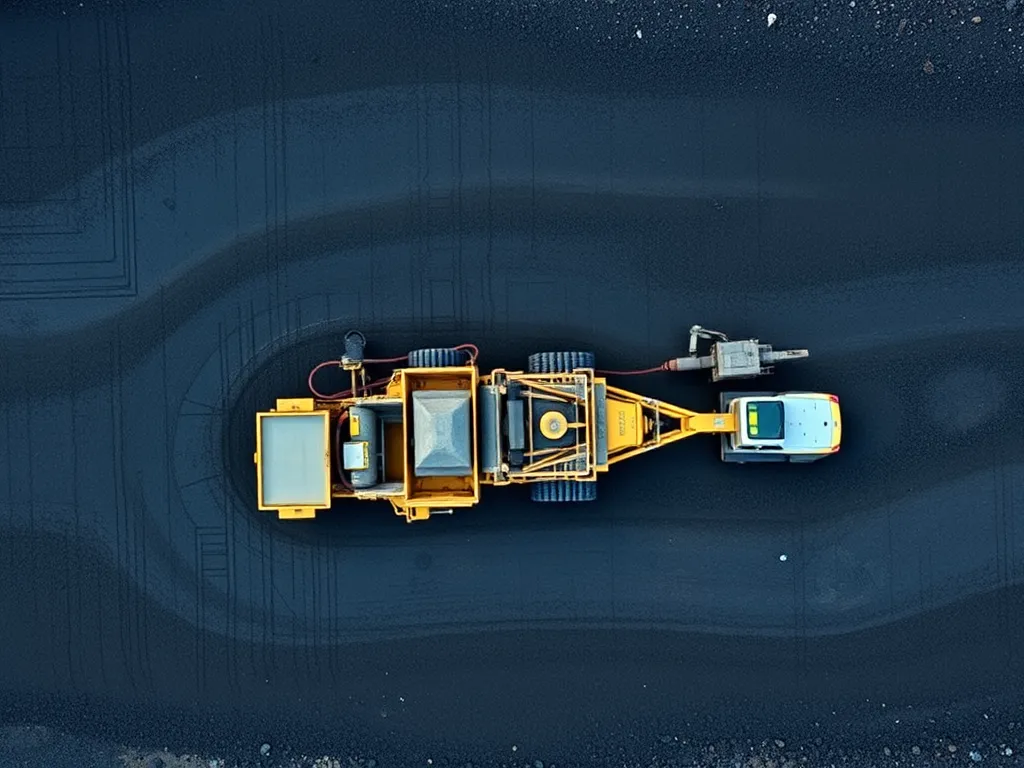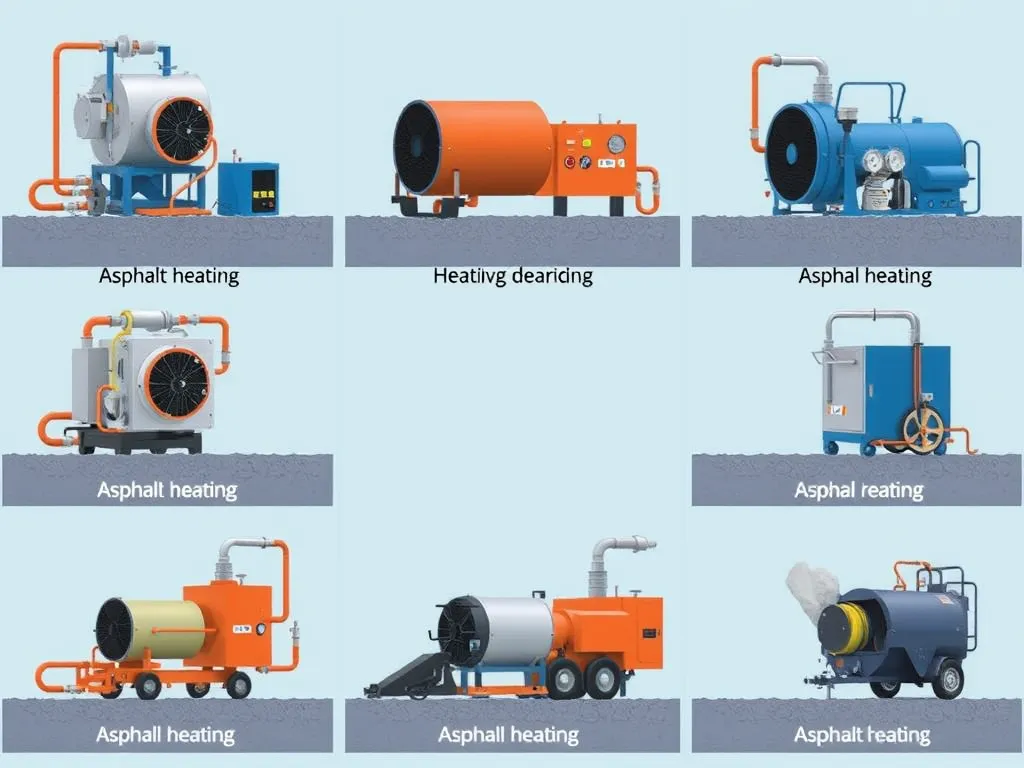The Importance Of Personal Protective Equipment for Asphalt Work
Published on: April 24, 2025 | Last Updated: April 14, 2025
Written By: George Voss
Personal protective equipment (PPE) for asphalt work includes specialized gear like heat-resistant gloves, respirators, and safety goggles that shield workers from burns, toxic fumes, and physical injuries. These items meet OSHA Standard 29 CFR 1910.132 requirements, ensuring compliance while handling hot asphalt mixtures exceeding 300°F. Proper PPE reduces risks like third-degree burns from molten asphalt or lung damage from carcinogenic fumes containing polycyclic aromatic hydrocarbons (PAHs).
This article explains which PPE matters most for asphalt jobs and why. You’ll learn how respirators filter 95% of airborne particles (NIOSH N95 or P100 ratings), why ANSI-certified hard hats resist impacts, and how PVC-coated jackets block splashes. We’ll also detail OSHA fines for non-compliance (up to $15,625 per violation) and best practices for maintaining gear.
Contents
- Understanding Personal Protective Equipment (PPE) in Asphalt Work
- Primary Hazards Of Asphalt Work
- Essential PPE for Asphalt Workers
- Why PPE is Critical for Asphalt Work Safety
- Best Practices for PPE Use in Asphalt Work
- OSHA Regulations and Compliance
- FAQs About PPE for Asphalt Work
- Closing Thoughts
- Additional Resources for You:
Understanding Personal Protective Equipment (PPE) in Asphalt Work
PPE refers to gear designed to shield workers from risks linked to their tasks. In construction settings, this term covers items like gloves, respirators, hard hats, or specialized clothing. For those handling hot mix asphalt, PPE serves as the first line of defense against extreme temperatures, toxic fumes, or physical injuries.
What Does PPE Stand for?
PPE stands for Personal Protective Equipment. This term is used globally in occupational safety protocols. In asphalt contexts, it specifically relates to tools that guard against burns, chemical exposure, or flying debris during roadwork. Proper use ensures workers meet both safety goals and regulatory requirements set by bodies like OSHA.
Role Of PPE in Mitigating Asphalt Work Hazards
Hot asphalt emits fumes exceeding 300°F, posing risks of burns or respiratory harm. PPE like heat-resistant gloves with Kevlar stitching can withstand temps up to 500°F. Respirators with P100 filters block 99.97% of airborne particles, including carcinogens like polycyclic aromatic hydrocarbons (PAHs). Safety goggles prevent eye injuries from splashes, while steel-toe boots with slip-resistant soles reduce trip hazards on uneven surfaces.
Beyond physical protection, PPE compliance helps firms avoid OSHA fines up to $15,625 per violation. For instance, NIOSH studies show consistent respirator use lowers fume exposure by 85% during paving operations. Investing in gear like cooled gel inserts for gloves or UV-protective sleeves also combats heat stress, which accounts for 30% of non-fatal construction injuries yearly.
Recognizing the function of PPE sets the stage for examining the specific dangers faced during asphalt operations.
Primary Hazards Of Asphalt Work
Asphalt work exposes crews to three core hazard categories. Each demands specific defenses through personal protective equipment asphalt teams rely on daily.
Physical Hazards: Burns, Abrasions, and Impact Risks
Hot-mix asphalt reaches 300°F–350°F during paving. Direct contact causes third-degree burns in under 5 seconds. Flying aggregate chips, machinery collisions, and dropped tools add impact risks. Rough surfaces like reclaimed asphalt pavement (RAP) scrape exposed skin during handling.
Key defenses:
- Heat-resistant gloves rated for 500°F+
- ANSI-certified hard hats with face shields
- Puncture-proof boots with steel toes
Chemical Hazards: Fumes, Vapors, and Hot Asphalt Exposure
Heated asphalt releases fumes containing polycyclic aromatic hydrocarbons (PAHs)—linked to lung damage and cancer with prolonged exposure. Workers within 12 feet of paving equipment face benzene levels up to 1.2 ppm, exceeding NIOSH’s 0.1 ppm limit.
Half-mask respirators with P100 filters block 99.97% of airborne particles. Full-face shields prevent skin contact with toxic vapors during kettle repairs or tank cleaning.
Environmental Hazards: Heat Stress and Weather Conditions
Paving crews endure ambient temperatures exceeding 100°F near 300°F asphalt. Heat stress causes 37% of construction fatalities. Rain creates slippery surfaces, increasing fall risks near machinery. High winds spread fumes beyond work zones.
Moisture-wicking clothing, cooling vests, and UV-protective gear help maintain core body temperatures below 100.4°F—the threshold for heat stroke.
Recognizing these hazards underscores the need for properly selected gear—next, we break down the essential PPE every asphalt worker requires.
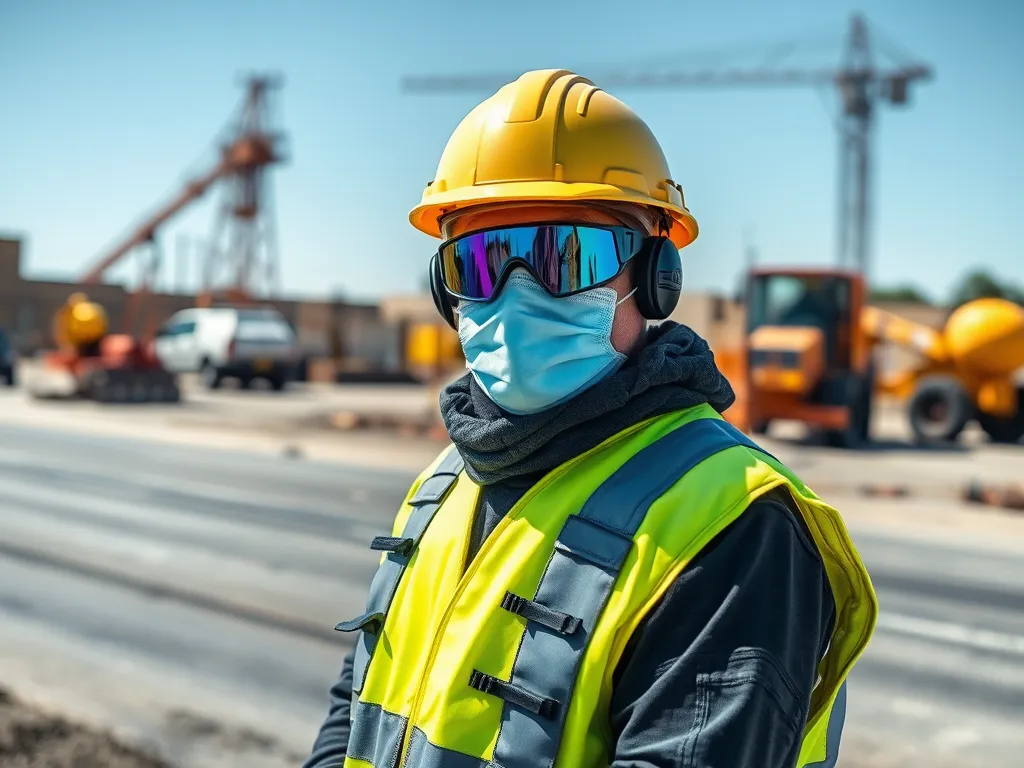
Essential PPE for Asphalt Workers
Working with hot asphalt demands gear designed to handle extreme temperatures, chemical exposure, and physical risks. Each piece serves a specific role in shielding workers from harm.
Head Protection: Hard Hats and Bump Caps
Hard hats meeting ANSI Z89.1-2014 standards guard against falling tools or debris at job sites. Bump caps with padded shells suit confined spaces where head bumps occur. Both shield scalps from asphalt splatter reaching 300°F during application.
Eye and Face Protection: Safety Goggles and Face Shields
Polycarbonate goggles with wraparound seals block airborne asphalt particles and fumes. Full-face shields add a layer when handling hot mix or operating machinery. ANSI Z87.1-rated options resist impacts and UV radiation common in outdoor paving.
Respiratory Protection: Respirators for Fume Mitigation
Asphalt fumes contain polycyclic aromatic hydrocarbons (PAHs) linked to respiratory issues. NIOSH-approved N95 respirators filter 95% of particulates. For high-fume tasks like kettle operations, half-mask respirators with P100 filters or supplied-air systems reduce exposure below OSHA’s 5mg/m³ 8-hour limit.
Hand and Arm Protection: Heat-resistant Gloves
Gloves with Kevlar or aluminized fabrics withstand temperatures up to 500°F during asphalt raking or drum handling. Extended cuffs prevent hot material from sliding into sleeves. ANSI Cut Level A3 ratings ensure protection against abrasions from aggregate.
Foot Protection: Heavy-duty Work Boots
ASTM F2413-18-rated boots with steel toes guard against crushing injuries. Slip-resistant soles with heat-resistant treads maintain grip on oily surfaces. Metatarsal guards add defense when handling heavy paving equipment.
Body Protection: Long-sleeved Clothing and PVC Coats
Flame-resistant, high-visibility shirts and pants minimize skin exposure. PVC-coated jackets repel molten asphalt splashes during pouring or repair work. Choose breathable fabrics with moisture-wicking properties to combat heat stress.
Proper PPE selection lays the groundwork for addressing safety protocols outlined in OSHA’s 29 CFR 1926 standards. Next, let’s examine how these measures directly prevent workplace injuries.
Also See: Asphalt Durability for Commercial Projects
Why PPE is Critical for Asphalt Work Safety
Work with hot asphalt brings high heat, fumes, and risks. The right gear blocks harm. Let’s break down three key reasons ppe matters.
Preventing Burns and Skin Injuries
Hot asphalt hits 300°F. Skin contact causes burns in seconds. Heat-safe gloves block burns. Long sleeves shield arms. Boots with thick soles guard feet from spills. Gear must cover all skin near hot mix. Even small gaps risk blisters or scars. Check gear for tears before each shift.
Reducing Inhalation Risks From Asphalt Fumes
Fumes from hot mix hold toxic PAHs (polycyclic aromatic hydrocarbons). These harm lungs over time. Use N95 masks for light fumes. For heavy vapors, wear half-face respirators with OV filters. OSHA sets fume limits at 5 mg/m³ over 8 hours. Without masks, workers face coughs, dizziness, or long-term lung issues.
Ensuring Compliance With OSHA Safety Standards
OSHA rules say firms must give workers free ppe. For asphalt, this includes eye shields, gloves, and respirators. Rule 29 CFR 1926.65 covers hazmat gear. Fines hit $15,625 per violation. Gear checks and training logs prove compliance. No exceptions for small crews or short jobs.
But safety does not end with gear alone. Next, we’ll show how to use ppe right—from fit checks to clean steps.
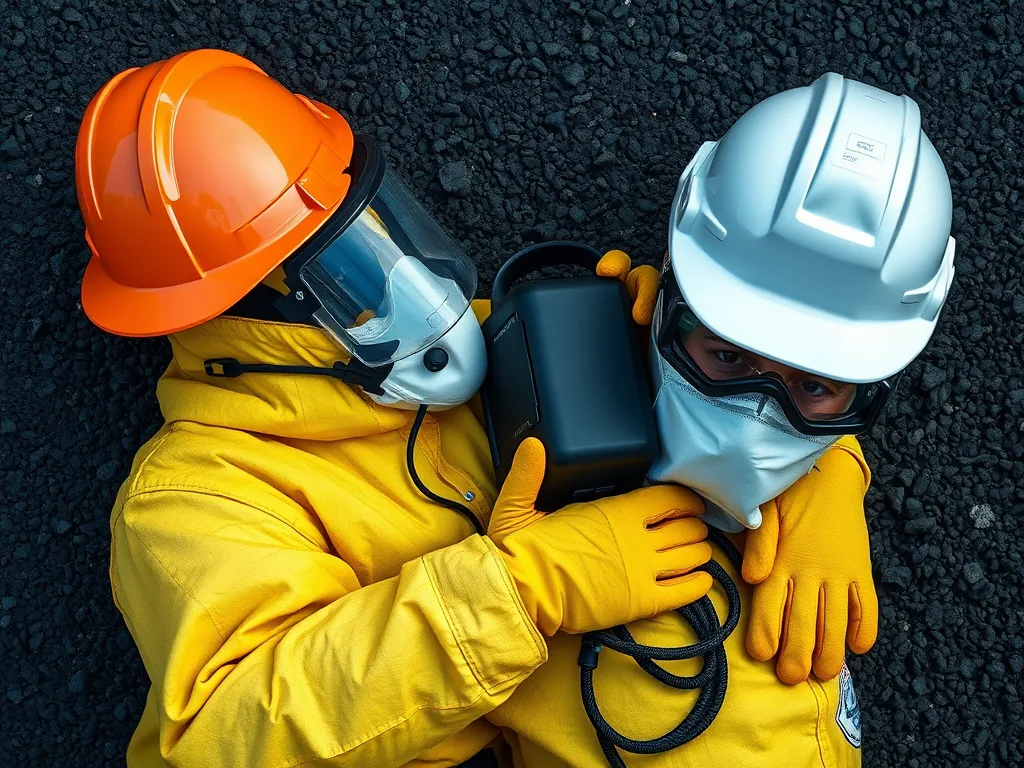
Best Practices for PPE Use in Asphalt Work
Effective use of personal protective equipment asphalt demands more than simply wearing gear. Proper protocols ensure maximum protection against burns, fumes, and physical hazards common in roadwork. Let’s break down three core practices every crew should follow.
Proper Fit and Maintenance Of PPE
PPE that doesn’t fit correctly offers reduced defense. Respirators require tight seals around the nose and mouth—NIOSH-approved models like N95 or P100 lose up to 60% efficiency with gaps. Heat-resistant gloves must cover wrists fully without restricting movement. Inspect gear daily: replace cracked face shields, check for frayed seams on PVC coats, and clean reusable items with pH-neutral solutions. Store work boots away from direct sunlight to prevent rubber degradation.
Pre-work Safety Checks and Hazard Assessments
Before handling hot mix asphalt (300-350°F), teams must evaluate risks. OSHA mandates formal Job Hazard Analyses (JHAs) to identify site-specific threats like airborne vapors or uneven terrain. Verify ambient temperatures exceed 50°F for proper binder adhesion, which affects spill risks. Confirm all crew members have ANSI-certified hard hats, goggles without scratches, and respirators with unexpired cartridges. Test asphalt temperature sensors to avoid thermal burns during application.
Safe Removal and Storage Of Contaminated PPE
Asphalt residues contain polycyclic aromatic hydrocarbons (PAHs), linked to skin irritation. Remove gloves by gripping the cuff edge, turning them inside out to trap contaminants. Bag soiled gear in labeled polyethylene containers—never mix with clean items. Decontaminate safety goggles using isopropyl wipes; launder flame-retardant clothing separately at 140°F. Dispose of asphalt-coated respirator filters per local hazardous waste rules.
Adhering to these steps minimizes exposure risks during asphalt operations. Next, let’s examine how federal regulations shape PPE requirements for road crews.
OSHA Regulations and Compliance
The Occupational Safety Health Administration sets strict rules for personal protective equipment asphalt workers must use. These standards protect against burns, chemical exposure, and airborne particles common in roadwork. Failing to meet these requirements risks fines up to $15,625 per violation under 29 CFR 1926.101 and 1926.28.
Overview Of Osha-required PPE for Asphalt Operations
OSHA mandates eight key items for asphalt personal protective equipment: hard hats rated for electrical hazards (Type II), ANSI-approved safety goggles, N95 respirators for fumes, heat-resistant gloves with 500°F ratings, steel-toe boots with slip-resistant soles, long-sleeved flame-retardant clothing, face shields during material loading, and hearing protection above 85 dB. Asphalt mix temperatures reaching 300°F make these non-negotiable defenses.
Employer Responsibilities in Providing PPE
Employers must supply all ppe for asphalt work at zero cost to workers under 29 CFR 1910.132. This includes replacing worn gear like cracked goggles or degraded respirator cartridges. Training programs covering proper use of heat-resistant gloves and emergency removal procedures for contaminated clothing are legally required. Daily equipment checks logged via ASTM F2413 standards ensure accountability.
Beyond gear selection, proper protocols separate compliant sites from hazardous ones. Next, let’s examine how consistent ppe usage directly prevents common asphalt injuries.
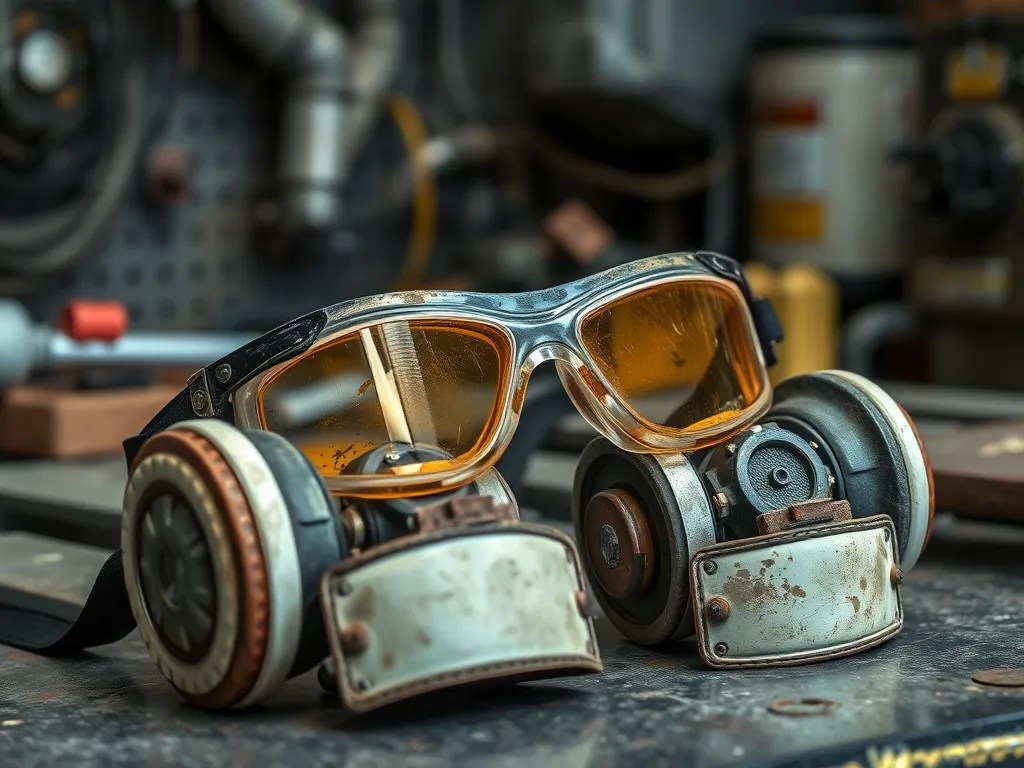
FAQs About PPE for Asphalt Work
What PPE is Required for Asphalt Work?
In asphalt work, the essential PPE includes hard hats, safety goggles, respirators, heat-resistant gloves, heavy-duty work boots, and long-sleeved flame-retardant clothing. Each item is designed to protect against specific hazards such as heat, fumes, and physical injuries.
Why is PPE Important in Construction and Asphalt Projects?
PPE is vital in construction, particularly in asphalt work, because it helps prevent serious injuries and health risks associated with exposure to hot materials, toxic fumes, and physical hazards. Proper PPE ensures compliance with safety regulations and promotes a culture of safety in the workplace.
What Precautions Should Be Taken When Repairing Asphalt?
When repairing asphalt, it’s crucial to conduct a thorough hazard assessment, ensure proper ventilation, and wear appropriate PPE such as gloves, goggles, and respirators. Workers should also be trained in safe handling procedures to minimize risks associated with hot asphalt and fumes.
Closing Thoughts
Personal protective equipment (PPE) is a non-negotiable aspect of asphalt work safety. The range of hazards, from physical burns to chemical fumes, highlights the necessity of appropriate gear. By equipping workers with hard hats, gloves, goggles, and respiratory protection, we significantly reduce the risk of injury and ensure compliance with OSHA safety standards.
Ongoing training and strict adherence to PPE protocols help protect workers from potential dangers. Best practices, such as ensuring a proper fit and maintaining equipment, further enhance safety in the field. Consistent use of PPE not only safeguards individual health but also fosters a culture of safety within the workplace.
For more information on asphalt work and safety measures, check out Asphalt Calculator USA.
Additional Resources for You:
- National Asphalt Pavement Association (NAPA, Industry Reports & Best Practices)
- Asphalt Paving Safety: A Comprehensive Guide | Tracey Road Equipment
- Asphalt: Hazards, Precautions, and More of What You Should Know
- Asphalt Safety Made Simple: Top Tips for Crews – Southeastern Equipment
- Asphalt Plant Safety: Key Equipment Features and Best Practices – Equipment & Contracting

